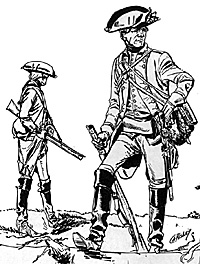 "No doubt my misfortunes have reached your ears ... I was made prisoner the 27th day
of August past by a people called Heshens, and by a party called Yagers, the most inhuman of all mortals. . . "
"No doubt my misfortunes have reached your ears ... I was made prisoner the 27th day
of August past by a people called Heshens, and by a party called Yagers, the most inhuman of all mortals. . . "
"The... columns will be led by the jagers who have reconnoitered the roads. . . "
"General Arnold praised the courageous behavior of the Hessian lagers. . . "
These three quotes, from altogether different sources, give us an idea of what some of his contemporaries thought of the German Jager or chasseur, an elite marksman and light infantryman who played an important part in the American Revolution.
Although the stereotype of the Hessian soldier is a blundering, phlegmatic figure loaded down with burdensome packs, satchels and hardware, the Jager was the exact opposite--a light-footed woodsman--keen, resourceful and independent. The Hesse-Cassel Jager Corps, commanded by Major von Wurmb, was considered one of the top units in the Anglo~German army, and detachments of it played key roles in almost every major engagement.
Captain Johann von Ewald, a promising young officer of the Corps, described many of these hot contests in his memoirs, written some time afterward when he had risen to prominence in Europe as a general in the Danish Army.
Jagers, in units of varying size, were provided by Brunswick, Hesse-Hanau, and Ansbach-Bayreuth, as well as Hesse-Cassel. It is questionable whether or not all the men serving in Jager detachments were really marksmen, especially in the later years of the war, when German recruiters began scraping the bottom of the barrel, but, at least in the case of the Hessian Jager Corps, the performance was top rate from beginning to end. In contemporary orders of battle and dispatches, the Jagers are often referred to as chasseurs, the equivalent French word. This was due mainly to current tastes, no less a German leader than Frederick the Great stating that he only used German to communicate with his servants and his dogs. One must question the last part of this statement, since most of Frederick's dogs were Italian Greyhounds, but it does help explain the scarcity of the word "Jager" in accounts in which these troops played an important role.
Dark green, the traditional huntsman's color, was worn by all the German Jager detachments. Hesse-Hanau and Hesse-Cassel Jagers had crimson facings and silver buttons while those of Brunswick and Ansbach-Bayreuth were clad in red-faced coats with yellow metal buttons. In the summer, Hessian Jagers abandoned their green breeches for lighter buff-colored ones. Vests were green in all cases, as were the cockades. Belting was natural brown.
Footwear varied. The Brunswick Jagers wore brown gaiters, as did some Hessian Jagers, however, in the case of the Hessians, boots were also issued. These were polished black leather. It is to be remembered that there was a mounted squadron of Hessian Jagers leased to George III along with the foot companies.
The cocked hat was black, and the straight edged hunting sword fitted in gold, with a black leather sheath. The stubby, rifled carbine had a white metal barrel, firing mechanism and ramrod. The rest of its fittings were brass.
The illustration appearing with this article is printed by courtesy of the artist, Clyde Risley of Imrie/Risley Miniatures, whose firm has produced an excellent 54mm casting of a Hessian Jager which cannot be praised too highly. There are many flat representations of this light infantry elite, most intended to depict Prussian Jagers of the Seven Years War, but quite usable as Hessians serving in America during the Revolution.
Numerous Hessian and Prussian musketeer castings in 20 and 30mm scale can be converted to the same end , the main problems being the lack of a cartridge box on the waistbelt, and the need to alter the shoulder belt.
Some years ago, John Scheid produced an interesting 54mm casting of a Hessian Jager. While it has since been superceded by better efforts, it is quite a curiosity, and worth acquiring if only because of the size of the hat, an item which would have made the late Hedda Hopper blush with envy.
Back to The Armchair General Vol. 2 No. 2 Table of Contents
Back to The Armchair General List of Issues
Back to MagWeb Master Magazine List
© Copyright 1969 by Pat Condray
This article appears in MagWeb (Magazine Web) on the Internet World Wide Web. Other military history articles and gaming articles are available at http://www.magweb.com
